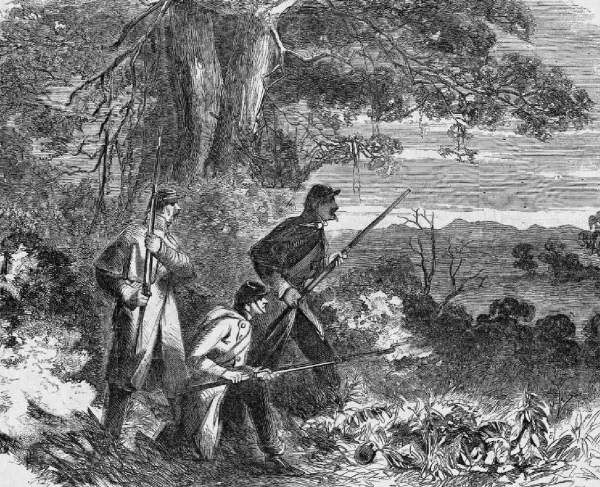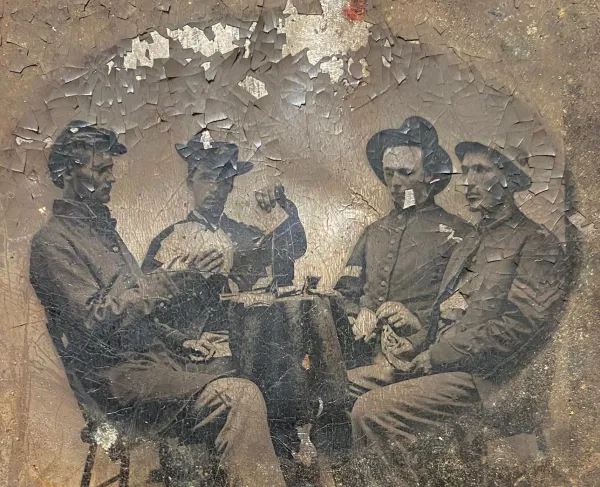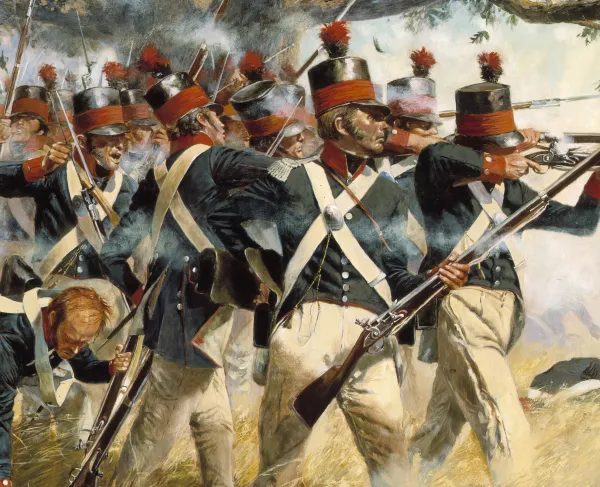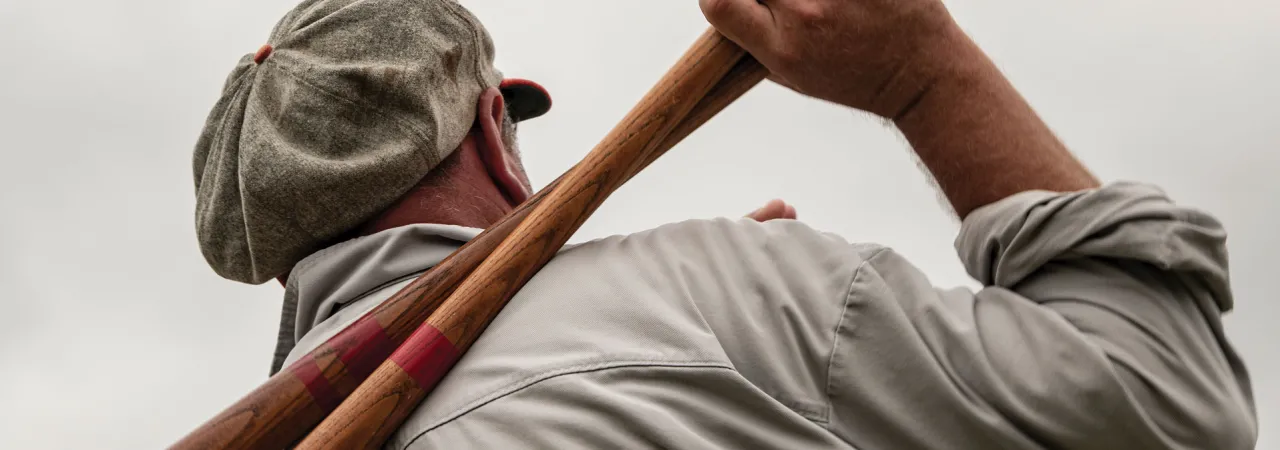
A striker (or batter) for Flemington Neshanock
With the sun beating down on their backs, their brows slicked with sweat and hands devoid of gloves, the Allegheny Iron Sides braced for impact in their defensive positions on a hilly ball field in south-central Pennsylvania. With one out needed, the ball club hungers to get back at bat. And just like that, Allegheny’s hurler (aka, the pitcher) sends the ball toward the striker (aka, the batter) from the Keystone Base Ball Club of Harrisburg. A solid hit off the wooden bat drives the ball into the infield, only to be carefully caught on a single hop — which counts for an out under the vintage rules in use at the Gettysburg National 19th Century Base Ball Festival.
This two-day July festival brings history alive in a way typical reenactments do not, as these 24 teams play 48 games across five ball fields, abiding by a historical set of rules for the sport we now know as baseball. The fields where they gather at the Schroeder Farm were used as a staging area for Pickett’s Charge and a post-battle field hospital; more recently, they were a filming location for the 1993 film Gettysburg and are routinely used for reenactments.
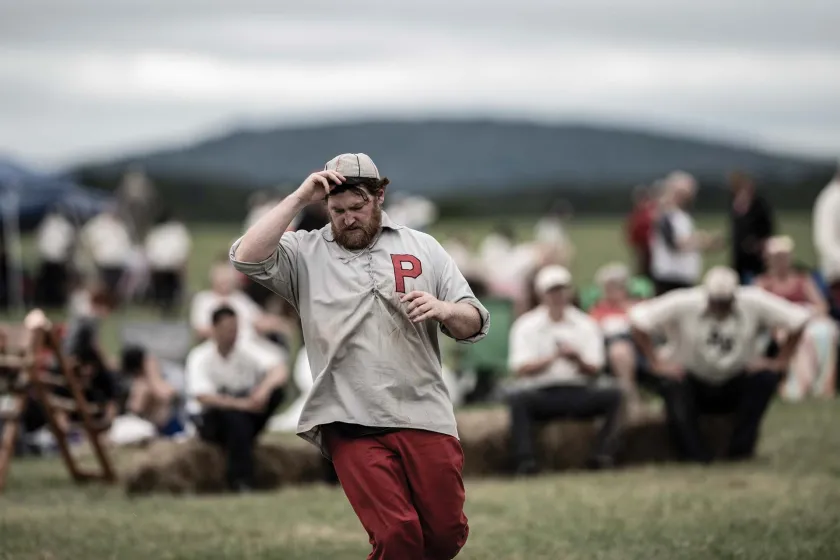
The 40 rules and regulations that guide these vintage-clad players were set forth by the National Association of Base-Ball Players on December 9, 1863. And, as time often spurs change, a peculiar few stand out to the modern mind: No gloves. No catching equipment. No pitcher’s mound—instead, a designated hurler’s area, from which the ball is thrown underhand. One ball—between 3.5 and 3.75 ounces—used the entire game. A striker is retired if the fielder catches the ball on one bounce or in the air, including foul ticks to the catcher.
But some elements are quite familiar: Nine innings. Nine players to a side. Constant comradery.
There was no better place for comradery than on the front lines of the American Civil War, as men from all walks of life united for a common cause. Baseball became a diversionary source of comfort and physical conditioning among the troops, while it simultaneously reinforced the power of teamwork. Other competitive sports like racing, wrestling, boxing, cricket and football all had their presence in wartime camps, but there was nothing quite like the attention baseball received, even amid pending peril. While stationed in Virginia, Frederick Fairfax of the 5th Ohio Infantry wrote in an April 3, 1862 letter:
“It is astonishing how indifferent a person can become to danger. The report of musketry is heard but a very little distance from us … yet over there on the other side of the road is most of the company, playing [baseball] and perhaps in less than half an hour they may be called to play a ball game of a more serious nature.”
At the recent festival, Justin “Bulldog” Deemer of the Keystone Base Ball Club said it best: “Baseball exploded because of the Civil War,” as soldiers from New York, Massachusetts and Pennsylvania shared their own unique versions of the bat and ball sport. Especially popular in working- and middle-class urban communities — notably with Irish and German immigrants — baseball had arisen as the choice pastime in New York by the 1850s. An older bat and ball game, “town ball,” persisted in Philadelphia, while in Boston and surrounding towns, New England Yankees put their own “Massachusetts game” spin on the sport.
But the “New York game” would ultimately take hold, as its players had not only paved a path to formal rules, but were also some of the most fervent supporters of the Union war effort. It was New Yorkers from the 71st New York Regiment who would play against the Washington Nationals amateur club in the first organized baseball game of the war on July 2, 1861, crushing their opponent 41 to 13 in a park neighboring the White House.
Makeshift games were a necessity, boosting the morale of not only the players but also the spectators cheering on the sidelines. They even gained media attention on the home front, sending a signal to loved ones that their boys in blue still had their spirits. One of these games took place on Christmas Day 1862, in Hilton Head, South Carolina. The 165th New York Volunteer Regiment faced off against a mishmash team of soldiers from various Union states, attracting a crowd of nearly 40,000 soldier-spectators. With the New York game favored by most, John G.B. Adams of the 19 Massachusetts Regiment wrote that “base ball fever [had] broke[n] out.” Even the New England regiments succumbed to the New York rules during play with soldiers from various states.
In the spirit of democracy, baseball leveled the playing field, bringing officers and their men together in friendly competition. It wasn’t social standing or military rank that a man was judged for, but rather his athletic ability.
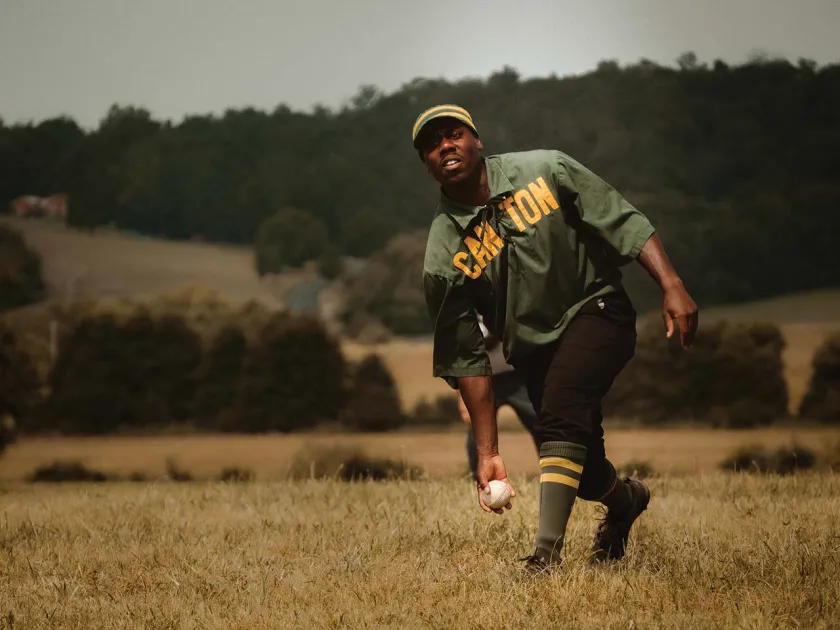
The current-day festival at Gettysburg allows you to consider this history, just miles from the renowned battlefield. But the event didn’t always feature Gettysburg as a backdrop; festival president and lead organizer, Bruce Leith, places its origins to Washington, D.C., in 2006 — where teams played in the shadow of the Washington Monument but roasted in the capital’s infamous humidity. Leith noted, “The only air we would ever get was when the president's helicopters moved overhead.”
Looking for a change and wanting to accommodate six different Pennsylvania ball clubs, the festival moved to Gettysburg in 2009 and was quickly embraced by the town’s Chamber of Commerce. Gettysburg Eddie’s, a restaurant named after Gettysburg’s own Hall of Fame pitcher Eddie Plank, even jumped on board as one of the annual event’s many sponsors — keeping the event free and accessible! There’s no denying that the festival’s unique characteristics are an attention-grabber for the history-loving crowds that flock to the renowned town.
And the festival gives back to the community that supports it. Gettysburg Little League manages parking for attendees, and in return, the event collects nearly enough donations each year to support the youth baseball program. In 2021, festival organizers also set their sights on aiding battlefield preservation, setting aside $2 from each pre-ordered t-shirt to benefit a pending American Battlefield Trust acquisition at Gettysburg.
By 2012, the festival had outgrown its original location at Hickory Hollow Farm, as more and more vintage ball clubs sought to be included. Today’s Shroeder Farm location allows for 24 clubs to rotate on five ball fields, with ample room for spectators, local vendors, concessions, parking and more. Traveling, often with families in tow, the teams do not take the festival hosts for granted, designating time at the end of every game to thank the Shroeder family, as well as the opposing ball players — by way of a cheerful chorus of “Hip hip hooray!” given from each team to the other.
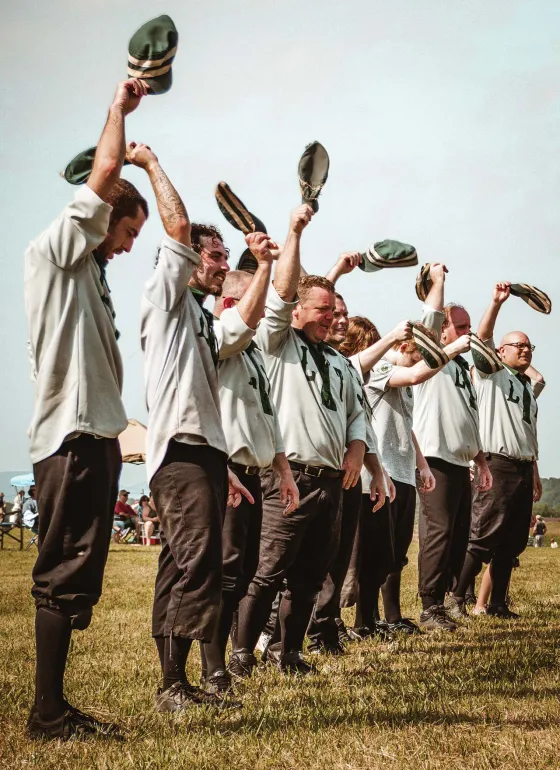
This year’s festival had the tone of a family reunion, with ball players from across the eastern United States — from Gettysburg itself to Nashville, Tennessee — playing two years of catch-up after last year’s festival was cancelled due to the ongoing COVID-19 pandemic. The fields were full of handshakes and spirited smiles, with story-filled nicknames shouted at every turn. When describing what constantly steers him toward the vintage game, Keystone’s Justin “Bulldog” Deemer emphasized “meeting great people and making lasting friendships.”
But there’s another element of intrigue for the players: Stepping back in time and looking at the game through a historical lens. Festival President Bruce Leith used to play for the Eclipse Base Ball Club of Elkton before he hung up his uniform for an administrative role, and something that fascinates him is the historical ties his club has to the Civil War. Formed by approximately six former Union surgeons who learned the game while serving alongside soldiers from New York and Philadelphia, the Elkton Club — says Leith — is one of several at the festival that can trace its beginnings to the nation’s defining conflict. The teams’ forebearers and their traditions have not been forgotten, as Justin Deemer reminds us:
“In 1864, the sport was supposed to be about being a gentleman. So, there was not spitting, no swearing; you shook hands, you congratulated an opposing player if they made a great play.”
But one element of the old-time game that today’s vintage ball players still find to be a vast challenge: “No gloves — that’s the hardest part,” says Deemer. “You’ve really got to be careful — I’ve dislocated fingers, damaged tendons.” The Allegheny Iron Sides’ Tabitha “Beer Tab” Leech advises you should “catch it like you’re catching an egg.”
The ball in question looks much different than what you’ll find at a modern-day ballpark. Covered in one piece of dark leather, the ball’s seams meet in an x configuration — unlike today’s ball, which is typically formed by the stitching together of two peanut-shaped pieces of white leather.
And when this ball is hit, it can truly sail. So much so that it easily sent fielders beyond spectators’ sight, as they scurried behind the rolling hills of the outfield to capture the leather-bound projectile and freeze base runners in their tracks. Unlike the level terrain of today’s ball fields, 19th-century ball fields were a product of convenience — determined by the availability of ample, accessible space, regardless of variations in topography. Mirroring the ball players who came before them, those at the current-day festival took the fields in stride, simply overjoyed to be playing alongside old and new friends.
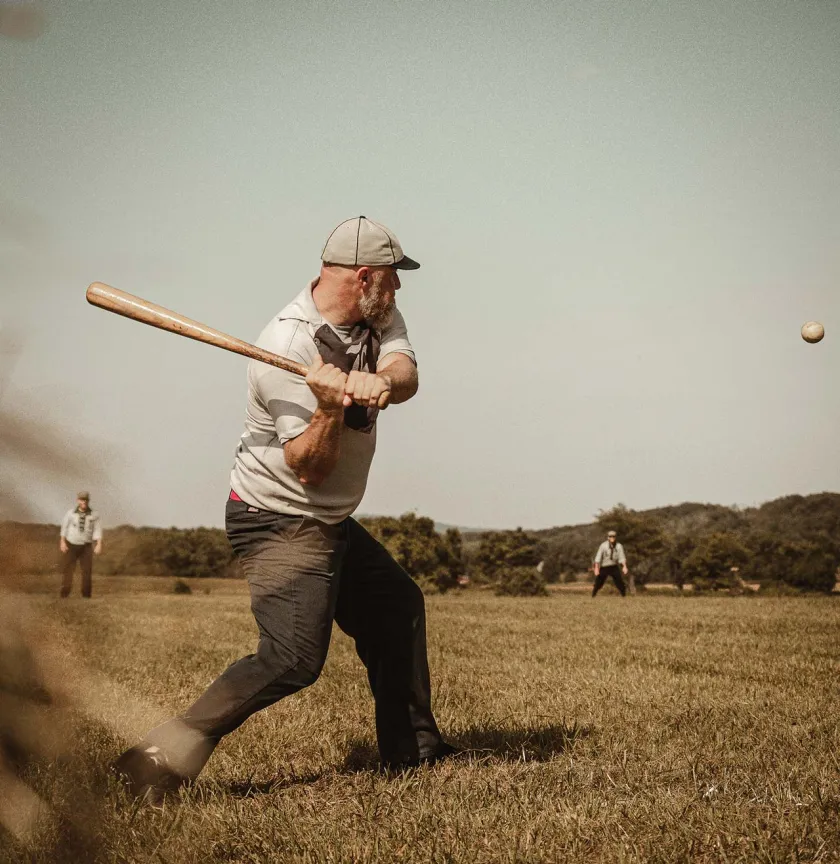
Vintage baseball doesn’t attract one particular age bracket or gender. For Gettysburg native and general manager of the hometown Gettysburg Generals, Rodney Helwig stresses, “All kinds, all forms. There is no age limit.... A couple of us are a little older, but most of my team is young. I’m related to a lot of the younger guys, and some of their friends have joined in, too.”
Tabitha “Beer Tab” Leech came to the Allegheny Iron Sides by chance when an open spot called for her talents, after years of playing baseball and softball. “I don’t mind being a female wearing this uniform. I respect everything that’s come from baseball — it's taught me a lot, on and off the field.” It’s a matter of what you put out on the field, and the heart you have for the game. Quite a few teams show that this passion starts early, with sluggers in the making serving as pint-size bat boys and girls, at times struggling to hoist the weight of the bat off the ground and back to the team bench.
According to the Vintage Base Ball Association, there are currently some 400 active clubs in a hobby that traces its existence to 1979 demonstrations at Old Bethpage Village Restoration on Long Island.
These players are a living reminder of the past. No matter the July heat, the players and spectators flock to Gettysburg to bask in an experience like no other. While the 1863 soldiers came to these fields with a much different purpose, chances are they would have also found solace in the game we now proudly call “America’s pastime.”

